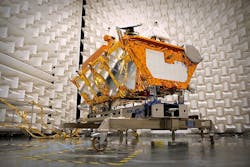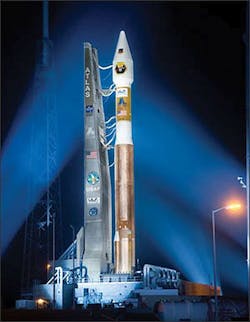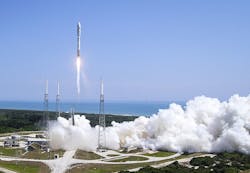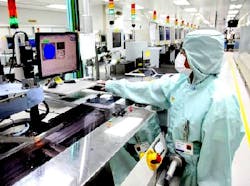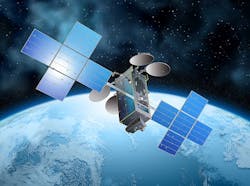Electrical, electronic, and electromechanical COTS components in space: penalizing policy
By Dan Friedlander
Retired following 44 years in components engineering
Looking at the relevant official policies of the space agencies (ESA, NASA, etc.), it seems that the policymakers are confident that EEE components availability is not something to be worried about, but history proves EEE components availability is driven by component manufacturers' business decisions and not by wishful thinking.
Official commercial EEE components usage policies are rather addenda to the traditional space methodology than a much-needed culture change. The official methodology of selecting and using EEE COTS components for space applications continues to be based on intensive testing/screening, rather than on the widely accepted methodology of statistical process control (SPC).
The traditional methodology of dealing with space/military grade EEE components has been extended (with some tailoring) to commercial EEE components. Beside locking new designs in usage of questionable EEE components availability, such an extended policy penalizes the use of EEE COTS components. Such policy not only imposes on the user a "last resort" selection path and a higher COTS ownership cost path, but also moves a heavy burden of unjustified (considering the COTS process control methodology) testing/screening from the components manufacturer to the user. It is widely accepted and widely proven that reliability of EEE components is built into them by design and by manufacturing process and not by testing/screening.
In spite of the questionable declining availability issue of space/military EEE components, the space authorities are reluctant to officially and timely recognize the EEE COTS components flight worthiness, under a new reality compliant methodology. Allowing use of EEE COTS components as last resort flight-worthy components within the traditional methodology, under a COTS penalization regime, is not a solution to secure designs and meet the foreseen global trends.
This article attempts to emphasize the rightness an applicable Albert Einstein quote: "We cannot solve our problems with the same thinking we used when we created them." In other words, methodology change invokes change of thinking.
The widely referenced NASA Goddard Space Flight Center (GSFC) Technical Publication NASA PEM-INST-001 (June 2003) - Instructions for Plastic Encapsulated Microcircuit (PEM) Selection, Screening, and Qualification is taken as an example of official old thinking. This document has been issued approximately one decade after a new COTS methodology has been adopted and implemented by the U.S. Department of Defense (DOD).
The inevitable real solution is to go for a new COTS methodology, based on the concept of process control rather than testing. The first priority for the EEE components selection process will be the EEE COTS components, similar to the present, already proven policy for military applications. The exclusive requirements for space applications will be dealt within the new methodology. To reach the cost goals, post procurement testing shall be minimized within a risk management regime.
Relevant documents
NASA is not the only space agency responsible to the issue of establishing EEE components-related rules. Following are NASA and ESA relevant documents, all following more or less the traditional approach:
NASA PEM-INST-001 (June 2003) - Instructions for Plastic Encapsulated Microcircuit (PEM) Selection, Screening, and Qualification.
NASA EEE-INST-002 (May 2003): Instructions for EEE Parts Selection, Screening, Qualification, and Derating.
NASA MSFC-STD-3012 REVISION A (February 14, 2012) - MSFC Technical Standard Electrical, Electronic, and Electromechanical (EEE) Parts Management and Control Requirements for MSFC Space Flight Hardware.
ECSS-Q-ST-60C Rev.2 (21 October 2013) - Space product assurance electrical, electronic and electromechanical (EEE) components.
ESA ECSS-Q-ST-60-13C (21 October 2013) - Space product assurance commercial electrical, electronic and electromechanical (EEE) components.
NASA PEM-INST-001
This a Goddard Space Flight Center (GSFC) Technical Publication widely referred to, dealing with plastic encapsulated microcircuits (PEMs).
Quote: "Due to the major differences in design and construction, the standard test practices used to ensure that military devices are robust and have high reliability often cannot be applied to PEMs that have a smaller operating temperature range and are typically more frail and susceptible to moisture absorption. In contrast, high-reliability military microcircuits usually utilize large, robust, high temperature packages that are hermetically sealed."
Contested: Standard test practices can be applied to PEMs, except the irrelevant ones (e.g. hermeticity, PIND). The plastic packages are smaller, more robust, less frail, more suitable at 2nd level connection (temperature variations). The moisture absorption is manageable (no need for hermeticity). The military operating temperature range is narrower in space applications. The widely use of "high-reliability military microcircuits" implies that COTS cannot be high-reliability components!
Quote: "Unlike the military high-reliability system, users of PEMs have little visibility into commercial manufacturers’ proprietary design, materials, die traceability, and production processes, and procedures. There is no central authority that monitors PEM commercial product for quality, and there are no controls in place that can be imposed across all commercial manufacturers to provide confidence to high-reliability users that a common acceptable level of quality exists for all PEMs manufacturers. Consequently, there is no guaranteed control over the type of reliability that is built into commercial product, and there is no guarantee that different lots from the same manufacturer are equally acceptable. And regarding application, there is no guarantee that commercial products intended for use in benign environments will provide acceptable performance and reliability in harsh space environments."
Comment: The use of the wording "guarantee" is inappropriate. No central monitoring authority can guarantee the level of reliability, quality and uniformity of any EEE Components. Refer to the history of space/military components' related failures and alerts.
The goal is not to reach the same EEE COTS level of reliability offered by space/military microcircuits. The goal is to reach an acceptable level of reliability, within the technical, availability and financial constraints.
The EEE COTS components have been used successfully in commercial and military harsh environments. The space is not a more severe environment than encountered in many military applications, except the radiation. The selected COTS shall meet the radiation requirements, like any selected space/military components. The radiation withstanding capability of an EEE Component is established by the die and not by the type of package (hermetic, nonhermetic) or the quality level (space, military, commercial).
Quote: "Product assurance methodology of most PEM manufacturers is based on the philosophy that the reliability must be designed or built into the manufacturing process rather than achieved by 100 percent testing of products. According to this methodology, the emphasis is on increasing the yield and reducing the likelihood of defective parts production by tight process control rather than on detection of failures during electrical testing."
Comment: This philosophy works well for high volume production, as practiced in the commercial industry. The military/space traditional methodology is based on testing, being a low volume production. The strict regime of heavy testing led to the huge technological gap between the commercial world and the space/military one.
Quote: "The qualification and screening processes contained in this document are intended to detect poor-quality lots and screen out early random failures from use in space flight hardware. However, since it cannot be guaranteed that quality was designed and built into PEMs that are appropriate for space applications, users cannot screen in quality that may not exist. It must be understood that due to the variety of materials, processes, and technologies used to design and produce PEMs, this test process may not accelerate and detect all failure mechanisms. While the tests herein will increase user confidence that PEMs with otherwise unknown reliability can be used in space environments, such testing may not guarantee the same level of reliability offered by military microcircuits. PEMs should only be used where due to performance needs there are no alternatives in the military high-reliability market, and projects are willing to accept higher risk."
Comment: According to this document in case of EEE COTS components usage in space applications the screening burden is moved from the component manufacturer to the user. Regardless of who is performing the screening, the technical scope of the testing stays as is. Screening addresses quality. Usually, most of the quality is determined by the amount of manufacturing defects found in a lot. The testing, as it is stated above, intends to detect those defects. It is agreed that manufacturing defects may result in failures. However, there is more than one way to address the issue of the manufacturing defects. Another way to deal with the defects is by attempting to prevent them.
The present EEE COTS components are manufactured in a rigorous statistical process controlled high-volume production regime. That results in a substantial better outgoing components' quality. This questions the need for 100 percent screening.
The term "guaranteed" is inappropriate in context of the terms "level of quality" and "level of reliability". The term "guaranteed" is inappropriate in context of the terms "level of quality" and "level of reliability". To be on the safe side, it has to be mentioned that reliability cannot be tested into EEE components. It is understood that the testing as per this document is intended to increase the user confidence in the tested PEMs.
It is also worth paying attention to the same meaningful NASA quotes from PEM-INST-001:
Quote from section 3.0: "There are numerous data indicating that improper handling and testing of the parts can introduce more defects than are screened out."
Quote from section 8.0: "Below are some additional guidelines for measures, which should be undertaken to avoid introduction of latent defects during testing, handling, and storing of the flight parts: Reduce handling by reducing the number of screening steps."
Comment: One of the more important decisions I made in the 90s, from the start of using EEE COTS Components, under a COTS first priority Selection Policy was: Do not test 100 percent of flight EEE components. Tested samples are not flown. A series of decisions resulted in a revolutionary methodology. The proof is in the pudding: multi-years, multi-satellites in LEO orbit, 100 percent success.
Quote from appendix A: "Screening of PEMs is essential before they are inserted into most flight hardware. The most important element in screening for reduced reliability risk for PEMs is burn-in."
Comment: In view of manufacturing COTS in a rigorous statistical process controlled high-volume production regime, resulting in a substantial better outgoing components' quality, in view of the potential damage to the test objects, in view of the costly infrastructure required for running and electrical verifying, it is worth to revisit the value of 100% burn in and the value of other post procurement 100 -percent screening.
Quote from section 2.3: "For all PEMs, qualification by flight history or similarity is not acceptable."
Comment: It is not understood why NASA is still following the traditional way of thinking, imposing such a general restriction on all PEMs. Qualification and reliability monitoring are performed routinely at least by best-in-class EEE COTS components manufacturers.
ESA ECSS-Q-ST-60-13C
This standard is applicable to commercial encapsulated active monolithic parts (integrated circuits and discrete).
Quote: "This standard applies only to commercial components - as defined in its scope - which meet defined technical parameters that are on the system application level demonstrated to be unachievable with existing space components or only achievable with qualitative and quantitative penalties."
COTS are considered inferior components to be selected as the last resort. ESA takes the same route.
Conclusion
Unless the policymakers know something that we (the users) do not know, it is not understood how and how long the space/military EEE components will survive.
The present official policies are still based on heavy testing rather process control. The EEE COTS components selection for flight is penalized at least by:
a. Imposing rules of last resort COTS selection.
b. Imposing a heavy post procurement testing burden on the users, ignoring the SPC contribution.
c. Higher cost of ownership.
There is a slight progress in the right direction by moving from COTS usage prohibition for flight to restricted COTS usage permission to fly. The progress is too slow, considering the uncertainty of the space/military components availability.
Procrastination is not the solution.
Dan Friedlander graduated ENGINEERING SCHOOL/TEL AVIV UNIVERSITY, physics 1965-1969. He has 44 years of experience in Component Engineering at MBT/ISRAELI AEROSPACE INDUSTRIES, 1969-2013, as Head of Components Engineering. He was responsible for all aspects of EEE Components (policy making, standardization at corporate level, approval, etc.) for military and space applications. Retired/Consultancy: 2013 - present. Further details of experience: see https://www.linkedin.com/in/dan-friedlander-63620092?trk=nav_responsive_tab_profile
Search the Aerospace & Defense Buyer's Guide
The go-to resource for Intelligent Aerospace technology news & information:
Covering key topics
Across all market segments
Subscribe to the free Intelligent Inbox e-newsletter
Subscribe to receive all the latest aerospace technology news & information, delivered directly to your e-mail inbox twice a week (Tuesdays and Thursdays). Sign upfor your free subscription to the Intelligent Inbox e-newsletter at http://www.intelligent-aerospace.com/subscribe.html.
Connect on social media
Keep pace with aerospace innovation and opportunities via your favorite social media channels. Connect with Intelligent Aerospace on Twitter (@IntelligentAero), LinkedIn,Google+, and Instagram.
